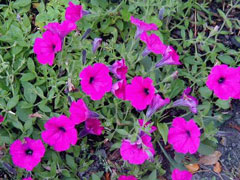


Home
Flowers &
Indoor Plants
Fruits & Nuts
Ornamentals
Vegetables
Special Topics
Resources
Glossary

Petunia |
 |
What about it? Petunia is a member of the Solanaceae or Nightshade Family and is therefore related to potatoes, tomatoes, eggplants, and tobacco. Nightshades contain chemicals called alkaloids that make their green or unripe parts poisonous. Petunia x hybrids is considered a cultigen - a plant that does not exist in the wild but is a hybrid, or mixture, of several different species. Petunias have either single or double flower heads with funnel-shaped flowers, 24" long, that ruffle at the edges. Petunias vary between 6" and 12" in height. What is it used for? Petunia is one of the most popular garden annuals. This is because it comes in so many different colors: crimson, blue, coral, cream, etc. They are found as bedding, border, and house plants, as well as in planters, window boxes, hanging baskets, and as cut flowers. Where does it grow? How do we grow it? Petunias like lots of sun and a moist, fertile, well-drained soil. Space 12" apart. They will bloom longer if the stems are cut back past the flowers on a regular basis. What are its primary problems? In addition to the extra maintenance for blooming, it is important to buy the smallest plants available and those that aren't in bloom. The blossoms may possibly become infected by botrytis blight during late spring rains. Some strains are more susceptible to air pollution and Japanese beetles. How do we propagate it? Sow the seeds indoors 8-10 weeks before the last frost. Do not cover the small seeds and keep temperature around 55 degrees F.
© Copyright, Department of Horticulture, Cornell University. |
